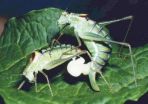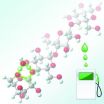(Press-News.org) This press release is available in German.
All a question of timing: When bushcrickets mate, the male attaches a sticky package, the so-called spermatophore, to the female's abdomen. Alongside the sperm themselves, this 'bridal present' consists of a protein-rich mass that the female eats after mating. It then takes several hours for the sperm to find their way into the female's reproductive tract. But, who decides when that will happen? A study by the Bielefeld biologists Professor Dr. Klaus Reinhold and Dr. Steven Ramm suggests that it is the male who determines the dynamics of this process even when he has long 'hopped off' somewhere else. They have now published their results in the online first version of the journal Behavioural Ecology and Sociobiology.
In contrast to direct sperm transfer, the use of a spermatophore could grant the female more influence over the fertilization or non-fertilization of her eggs. However, the results of the Bielefeld study cast doubt on this assumption. They suggest a high degree of male control over this decisive stage in reproduction. For their study, Professor Dr. Klaus Reinhold and Dr. Steven Ramm from Bielefeld University paired males and females from two subspecies of the bushcricket Poecilimon veluchianus in whom the time between pairing and sperm transfer differ. Whereas in the subspecies Poecilimon veluchianus minor, sperm are transferred within the first three hours, the transfer in Poecilimon veluchianus veluchianus starts only after four hours. If the two subspecies are interbred – the researchers thought – then the number of transferred sperm after three hours would indicate whether it is the male or the female who determines how long this transfer takes.
The researchers mated nine to twelve pairs in each of the four possible combinations of Poecilimon veluchianus minor and Poecilimon veluchianus veluchianus. Three hours after mating, they examined how many sperm they could find in the female's reproductive tract. The result: the sperm from the males of the 'faster' subspecies Poecilimon veluchianus minor could be found in the females of both subspecies. In contrast, the males in the 'slower' sub-species Poecilimon veluchianus veluchianus had transferred almost no sperm at all to either type of female.
The researchers conclude from this experiment that the males control the speed of transfer over the sperm package. However, this does not automatically lead to the conclusion that the female is powerless. Females can also influence whether sperms are transferred by how quickly they eat the spermatophore. In addition, the larger the male, the larger the size of the sperm package, and this influences how long the females need to consume the protein. As a result, the sperm have more time to transfer to the female – and the female's eggs have a greater chance of being fertilized by a 'high-quality' male. Professor Reinhold stresses, 'Our findings show that the females do not determine the transfer – not that they could not do so.'
INFORMATION:
Male bushcrickets are in charge when it comes to sex
Biologists at Bielefeld University publish research findings in specialist journal
2012-12-14
ELSE PRESS RELEASES FROM THIS DATE:
What mechanism generates our fingers and toes?
2012-12-14
Montréal, December 14, 2012 – Dr. Marie Kmita and her research team at the IRCM contributed to a multidisciplinary research project that identified the mechanism responsible for generating our fingers and toes, and revealed the importance of gene regulation in the transition of fins to limbs during evolution. Their scientific breakthrough is published today in the prestigious scientific journal Science.
By combining genetic studies with mathematical modeling, the scientists provided experimental evidence supporting a theoretical model for pattern formation known as the ...
Study fuels insight into conversion of wood to bio-oil
2012-12-14
New research from North Carolina State University provides molecular-level insights into how cellulose – the most common organic compound on Earth and the main structural component of plant cell walls – breaks down in wood to create "bio-oils" which can be refined into any number of useful products, including liquid transportation fuels to power a car or an airplane.
Using a supercomputer that can perform functions thousands of times faster than a standard desktop computer, NC State chemical and biomolecular engineer Dr. Phillip Westmoreland and doctoral student Vikram ...
Problems with mineral metabolism linked with kidney disease progression
2012-12-14
Highlights
In a study of African Americans with kidney disease, levels of mineral metabolites rose over time; those with faster rates of kidney function decline had the greatest increases in metabolites.
Higher baseline levels of metabolites were linked with an increased risk for kidney failure or death independent of kidney function.
Disordered mineral metabolism is more severe in African Americans with chronic kidney disease, which might partially explain why their disease progresses more rapidly to kidney failure.
Washington, DC (December 13, 2012) — Abnormalities ...
Researchers identify target to help protect kidney patients' heart health
2012-12-14
Highlights
Blocking the receptor for endothelin lowers novel cardiovascular risk factors in patients with chronic kidney disease independent of blood pressure.
The findings suggest that blocking the receptor may provide heart-related benefits to these patients.
60 million people globally have chronic kidney disease.
Washington, DC (December 13, 2012) — Blocking the receptor for proteins that constrict blood vessels reduces markers of heart-related problems in patients with chronic kidney disease (CKD), according to a study appearing in an upcoming issue ...
More bang for bugs
2012-12-14
A new study from the rainforests of Panama provides an unprecedented level of detail regarding the diversity and distribution of arthropod species from the soil to the forest canopy. Yves Basset, scientific coordinator of the CTFS Arthropod Initiative at the Smithsonian Tropical Research Institute, led an international team on Project IBISCA-Panama to sample, sort, catalogue, and finally estimate that a 6,000 hectare forest hosts a total of around 25,000 arthropod species – a figure vastly outnumbering that of better-studied organisms. The study will be published online ...
Psychosocial distress associated with increased stroke risk
2012-12-14
People over age 65 with high psychosocial distress face increased risk of stroke, according to new research in the American Heart Association journal Stroke.
Psychosocial distress is a broad concept that includes depression, stress, a negative outlook and dissatisfaction with life.
In their 10-year study, researchers followed 4,120 people in the Chicago Health and Aging Project for rates of death and stroke incidents. Due to some participants being involved in an HMO only 2,649 participants were analyzed for rates of incident stroke. Participants were 65 years and older ...
Building better structural materials
2012-12-14
Washington, D.C. — When materials are stressed, they eventually change shape. Initially these changes are elastic, and reverse when the stress is relieved. When the material's strength is exceeded, the changes become permanent. This could result in the material breaking or shattering, but it could also re-shape the material, such as a hammer denting a piece of metal. Understanding this last group of changes is the focus of research from a team including Carnegie's Ho-kwang "Dave" Mao.
Their breakthrough research on the behavior nickel nanocrystals under intense pressure ...
Data on financial crime is not credible
2012-12-14
The Government and police efforts to tackle financial crime – from business fraud to tax evasion – are hampered by a lack of accurate data about the nature and extent of offending, according to new research.
Most of the data available on financial crime is produced without a credible methodology, says Michael Levi, Professor of Criminology at Cardiff University, whose research was funded by the Economic and Social Research Council (ESRC).
"Typically, the information available on offending or threat is just a marketing hype," says Professor Levi. "It comes from business ...
Pheromone helps mice remember where to find a mate
2012-12-14
Scientists at the University of Liverpool have found that male mice produce a pheromone that provokes females and competitor males to remember a preference for the place where the pheromone was previously encountered.
Some animals, such as moths, use a sensitive tracking system to trace airborne sex pheromones to the source, while others, such as snakes, follow trails of pheromones left on the ground. A team from the University's Institute of Integrative Biology has discovered that mice use a different system to locate mates and competitors by remembering exactly where ...
Reality check for DNA nanotechnology
2012-12-14
Two major barriers to the advancement of DNA nanotechnology beyond the research lab have been knocked down. This emerging technology employs DNA as a programmable building material for self-assembled, nanometer-scale structures. Many practical applications have been envisioned, and researchers recently demonstrated a synthetic membrane channel made from DNA. Until now, however, design processes were hobbled by a lack of structural feedback. Assembly was slow and often of poor quality. Now researchers led by Prof. Hendrik Dietz of the Technische Universitaet Muenchen (TUM) ...
LAST 30 PRESS RELEASES:
Tracing the quick synthesis of an industrially important catalyst
New software sheds light on cancer’s hidden genetic networks
UT Health San Antonio awarded $3 million in CPRIT grants to bolster cancer research and prevention efforts in South Texas
Third symposium spotlights global challenge of new contaminants in China’s fight against pollution
From straw to soil harmony: International team reveals how biochar supercharges carbon-smart farming
Myeloma: How AI is redrawing the map of cancer care
Manhattan E. Charurat, Ph.D., MHS invested as the Homer and Martha Gudelsky Distinguished Professor in Medicine at the University of Maryland School of Medicine
Insilico Medicine’s Pharma.AI Q4 Winter Launch Recap: Revolutionizing drug discovery with cutting-edge AI innovations, accelerating the path to pharmaceutical superintelligence
Nanoplastics have diet-dependent impacts on digestive system health
Brain neuron death occurs throughout life and increases with age, a natural human protein drug may halt neuron death in Alzheimer’s disease
SPIE and CLP announce the recipients of the 2025 Advanced Photonics Young Innovator Award
Lessons from the Caldor Fire’s Christmas Valley ‘Miracle’
Ant societies rose by trading individual protection for collective power
Research reveals how ancient viral DNA shapes early embryonic development
A molecular gatekeeper that controls protein synthesis
New ‘cloaking device’ concept to shield sensitive tech from magnetic fields
Researchers show impact of mountain building and climate change on alpine biodiversity
Study models the transition from Neanderthals to modern humans in Europe
University of Phoenix College of Doctoral Studies releases white paper on AI-driven skilling to reduce burnout and restore worker autonomy
AIs fail at the game of visual “telephone”
The levers for a sustainable food system
Potential changes in US homelessness by ending federal support for housing first programs
Vulnerability of large language models to prompt injection when providing medical advice
Researchers develop new system for high-energy-density, long-life, multi-electron transfer bromine-based flow batteries
Ending federal support for housing first programs could increase U.S. homelessness by 5% in one year, new JAMA study finds
New research uncovers molecular ‘safety switch’ shielding cancers from immune attack
Bacteria resisting viral infection can still sink carbon to ocean floor
Younger biological age may increase depression risk in older women during COVID-19
Bharat Innovates 2026 National Basecamp Showcases India’s Most Promising Deep-Tech Ventures
Here’s what determines whether your income level rises or falls
[Press-News.org] Male bushcrickets are in charge when it comes to sexBiologists at Bielefeld University publish research findings in specialist journal


